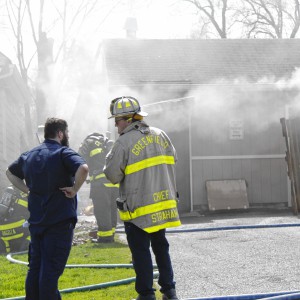My Turn: Reform needed to put education, economy on path to success
| Published: 02-20-2023 2:41 PM |
Children from every community across our commonwealth possess limitless potential, but that potential can fizzle quickly if it is not nourished and supported as they develop into adults. Most begin elementary school confident that their futures hold promise. Yet too often, as young people proceed through middle and high school, that spirit of positive momentum and hope is replaced by confusion and doubt that the best paths forward are available to them.
We work and reside in communities that would benefit from greater focus on preparing students for career pathways that can meet current workforce needs. Expanding these pathways matters not just to individual students, but to our capacity to meet statewide equity, workforce and economic goals.
This is particularly true at a time when clean tech, robotics, advanced manufacturing, life sciences and countless other industries require strong technical skills and offer not only good-paying entry-level jobs, but longer-term career ladders.
As organizational leaders who care deeply about both the future of our young people and the success of our state’s economy, we are concerned by the commonwealth’s 2022 scores on the National Assessment of Educational Progress (NAEP), which hit their lowest point since 2003. These scores reflect declines across nearly all school districts in both math and reading levels, with lower levels of proficiency shown in schools that serve high-needs students.
These test scores are consistent with feedback from businesses that there are not enough qualified candidates to fill jobs in today’s complex industries. But with more than a billion dollars in federal COVID relief funding for education still unspent, are we acting with sufficient urgency and specificity to prepare students to pursue careers that can provide family-sustaining wages?
If we are to ensure that today’s students have the knowledge and skills for tomorrow’s career opportunities, we need a comprehensive plan for student success.
Universities, community colleges, apprenticeships and career certificate programs all can lead to careers in industries that offer economic opportunity. What is clear is that students, beginning in middle school, need information and guidance about how to pursue careers that interest them, as well as equitable access to high school curricular options to prepare them to do so, such as AP courses, vocational education, internships, and courses that provide college credit.
Unfortunately, not all school districts currently offer their students pathways and career guidance that can connect them to opportunities in these burgeoning and good-paying industries.
Article continues after...
Yesterday's Most Read Articles
 Orange man gets 12 to 14 years for child rape
Orange man gets 12 to 14 years for child rape
 Cleary Jewelers plans to retain shop at former Wilson’s building until 2029
Cleary Jewelers plans to retain shop at former Wilson’s building until 2029
 Greenfield Police Logs: April 2 to April 8, 2024
Greenfield Police Logs: April 2 to April 8, 2024
 Fire scorches garage on Homestead Avenue in Greenfield
Fire scorches garage on Homestead Avenue in Greenfield
 One Greenfield home invasion defendant up for bail, other three held
One Greenfield home invasion defendant up for bail, other three held
 Two local school advocates tapped to lead state’s new Small and Rural Schools Committee
Two local school advocates tapped to lead state’s new Small and Rural Schools Committee
Across the commonwealth, there are initiatives in place such as Early College that are giving students a head start on their future. But these programs are not available at all high schools. We need to scale up Early College and other pathway programs and ensure they are aligned with opportunities in new and emerging industries — for example, the growing need for life sciences technicians, researchers, and manufacturing support. Moreover, middle and high schools need to ensure they have the capacity to provide all students with the kind of comprehensive guidance and follow-up they need.
That is why an alliance of groups committed to educational equity and that represent students, parents, educators and employers launched Student Pathways to Success, a new coalition that believes our education and workforce challenges are tightly connected. We can address these challenges by creating stronger connections between what students are learning in high school and the opportunities that await them when they graduate.
This is a moment for the new administration of Gov. Maura Healey and Lt. Gov. Kim Driscoll, as well as our new Legislature, to think and act boldly. Building on recent state efforts to expand Early College, career-vocational technical education, STEM-focused curriculum, and other evidence-based programs, state leaders should commit to a goal of creating universal student access to a robust system of college and career pathways.
The Student Pathways to Success coalition believes that every high school student in Massachusetts should be on a personalized pathway and have opportunities to earn college credit, participate in work-based learning, attain industry-recognized credentials, and receive dedicated career counseling.
According to a Student Pathways for Success poll conducted by Lincoln Park Strategies, voters are ready for action. Nearly nine in ten (88%) say Gov. Healey must put education improvements among her top priorities, with 20% saying it must be her top priority.
Reimagining high schools to give students a jump-start on their future must be at the top of our to-do list to expand opportunity and ensure the benefits of Massachusetts’ economic engine are shared by all.
Jay Ash is CEO of the Massachusetts Competitive Partnership and former Massachusetts Secretary of Housing and Economic Development. Ed Lambert is executive director of the Massachusetts Business Alliance for Education, former mayor of Fall River, and a former state representative. Cheryl Stanley is vice president of education programs and advocacy at The Urban League of Springfield.

 My Turn: Saving planet Greenfield
My Turn: Saving planet Greenfield Gary Seldon: Solar Roller Earth Day River Ride
Gary Seldon: Solar Roller Earth Day River Ride Mitch Speight and Joan Marie Jackson: City should follow constitutional ruling on property takings
Mitch Speight and Joan Marie Jackson: City should follow constitutional ruling on property takings Columnist Johanna Neumann: Reaping the rewards of rooftop solar
Columnist Johanna Neumann: Reaping the rewards of rooftop solar
